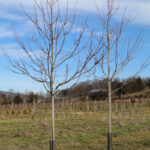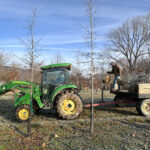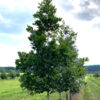As we begin 2024, we start by featuring a tree that was once a common ornamental in rural eastern North America, but has faded in popularity over the decades, the northern catalpa, Catalpa speciosa. Catalpa is a small genus of eight species—all trees—in the liana-heavy trumpet-creeper family, Bignoniaceæ. Two of these species are native to North America. The name ‘catalpa’ is derived from the Muscogee name for the tree, kuhtulpa, meaning ‘winged head’, a reference to the winged seeds of the tree.
Like its sister tree, C. bignonioides, the true native range of C. speciosa is still somewhat in question. Early botanical surveys found it growing in a relatively small geography near the mouth of the Ohio River and adjacent areas of the Mississippi valley, but more recent surveys have found evidence of a much wider range across eastern North America in the recent past. It is theorized that some event of series of events resulted in a sharp reduction in both catalpas’ native ranges some 300-500 years ago.
(Scroll down to continue…)
Catalpa speciosa is a coarse, relatively fast growing tree, usually peaking at 15-22 m (50-70 ft) in the landscape. From an irregular youth, northern catalpa tends to form an oval to upright-oval form at maturity. Lower branches can often sweep the ground when left unpruned. The leaves are cordate (heart-shaped) and quite large, up to 30 cm (12”) in length and breadth. The leaf color is a medium green with the undersides covered by a dense pubescence. It is typically one of the last trees to leaf out in spring, along with the black walnut (Juglans nigra). The leaves are followed 3-4 weeks later by flowers, borne in upright panicles of 10-30 orchid-like blossoms, white with yellow stripes and purple spots. The flowers give way to a slender seedpod, 20-40 cm (8-16”) in length and 12 mm (½”) in diameter resembling an oversize green bean. These ripen to rich brown in autumn (hence another common name ‘cigar tree’), then split, open, and fall over the winter releasing hundreds of small flat seeds with two papery wings. The winter leaf color is unremarkable, in some years the leaves turn yellow brown, but also often drop from the tree green after a hard freeze.
The mature bark of Catalpa speciosa is typically a dark brownish grey with numerous ridges and fissures. The wood is somewhat soft and prone to breakage but is very durable against rot. Numerous stands of catalpa were planted across the Midwest in pioneer days as ready source of fenceposts. The wood is also easily worked and has an attractive grain useful for furniture and carvings. It is also one of the few trees to tolerate alkaline soils, although C. speciosa also adapts well to a wide range of soil conditions. It is relatively pest free. The genus is the primary food source for the larva of the catalpa sphinx (Ceratomia catalpæ). Catalpa sphinx caterpillars, commonly called ‘catawba worms’ are highly sought after by fishermen as bait.
From an ornamental standpoint, Catalpa tends to invoke polarizing opinions…i e, you either love it or hate it in the landscape. On the positive side, the flowers are very showy and attractive, and the large leaves provide a tropical look to a summer afternoon. The dense foliage also provides ample shade. It is, however, a messy tree, with heavy accumulations of fallen flowers in the spring, large leaves to rake in the autumn, and the numerous seedpods which fall and disperse their seeds from late autumn through the following spring. It is also susceptible to wind and ice damage and can cause issues with water lines and foundations due to its coarse root system. It is undeniably though a spectacular ornamental when sited where its shortcomings are less problematic. You can find Catalpa speciosa available in 2”, 2½”, and 3” caliper for spring 2024.




![At the Nursery: Budding Out [Part 4]](https://whitehousenatives.com/wp-content/uploads/2024/04/Rapistrum-rugosum-turnipweed-winter-cover-100x100.jpg)

![At the Nursery: Budding Out [Part 3]](https://whitehousenatives.com/wp-content/uploads/2024/04/Carpinus-caroliniana-catkins-100x100.jpg)
![At the Nursery: Budding Out [Part 2]](https://whitehousenatives.com/wp-content/uploads/2024/04/Acer-rubrum-seed-pods-100x100.jpg)